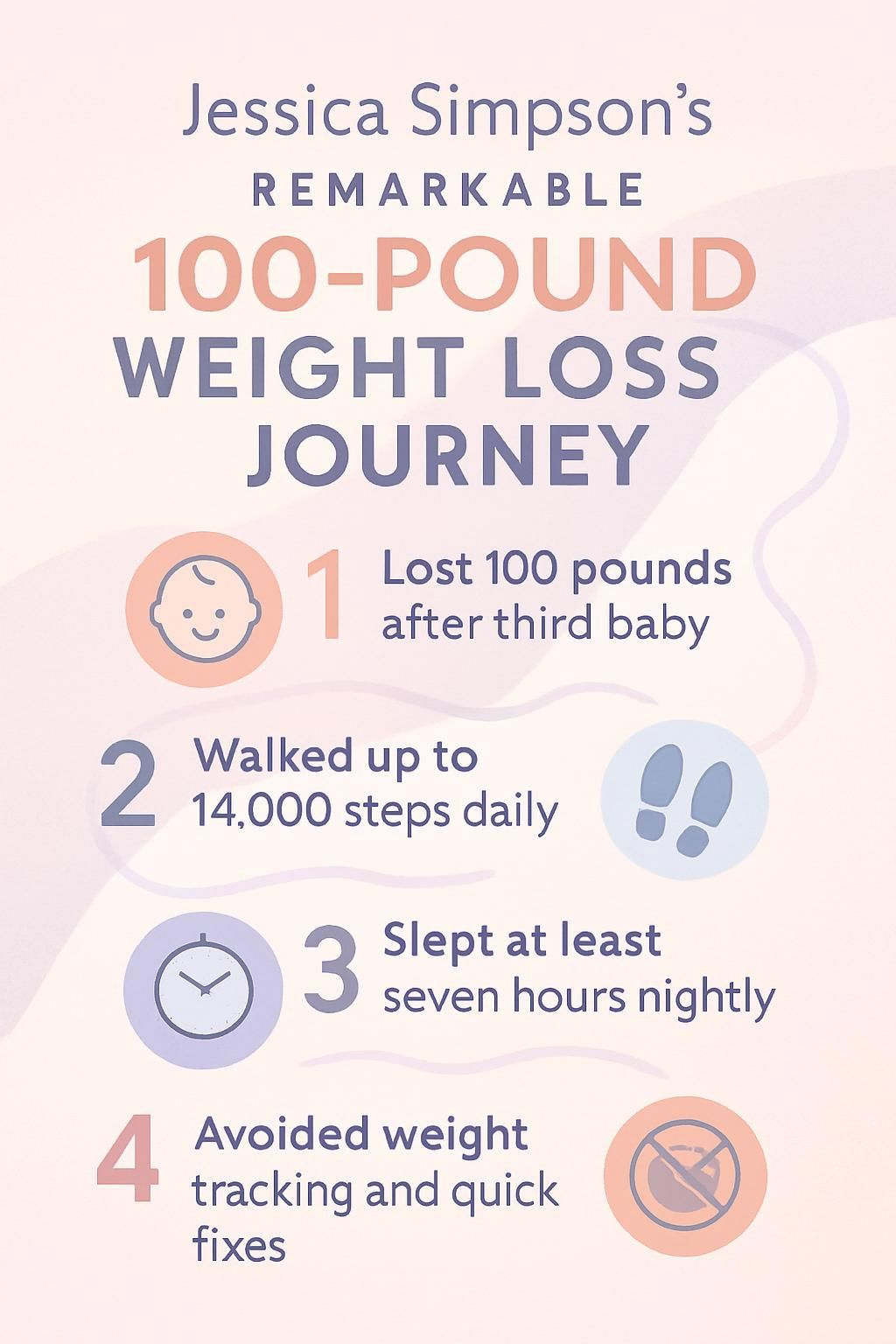Jessica Simpson’s Remarkable 100-Pound Weight Loss Journey
Our Nutrition Assistant AI Suite will transform your body. You will lose fat, get toned, and build muscle. Gain confidence and optimal health.
Feeling swamped by health advice and low on motivation? Jessica Simpson’s 100-pound weight loss drew attention because it came from steady habits, not shortcuts. Her plan mixed simple food rules, daily movement, and a kinder mindset.
This guide breaks down her steps so you can apply them to your own weight loss journey. You will see how to set clear goals, build routines you can keep, and stay inspired day after day.
Key Takeaways
- Jessica Simpson lost 100 pounds after her third child in 2019 using the Body Reset Diet and support from trainer Harley Pasternak.
- Her routine centered on three meals and two snacks each day, up to 14,000 steps daily, and resistance training three times per week.
- She cut alcohol, aimed for at least seven hours of sleep, and unplugged from screens for one hour daily to protect mental health.
- She threw away her scale to focus on body image, gratitude, and sustainable habits, instead of tracking weight or using drugs like Ozempic.
- Her story in People magazine and her memoir, Open Book, promotes balanced nutrition, self-acceptance, and lasting lifestyle changes for weight management.

Jessica Simpson’s Motivation for Change

Public attention and personal challenges pushed Jessica Simpson to reset her health after welcoming her third child. The goal was clear, feel stronger and build habits that last.
How did public scrutiny affect Jessica Simpson’s self-image?
Public scrutiny can shape how you see yourself. That happened to Jessica Simpson as early as 2005 during her Daisy Duke era. Headlines often centered on her size rather than her voice or business work.
In 2009, photos from a Chili Cook Off sparked harsh comments about high-waisted jeans. Reports say she wore a size 4 at roughly 120 pounds. In Open Book, she described how those moments hurt and lingered.
Constant criticism made every gain or loss feel bigger than it was. As she put it, “Those words stick with you.” Confidence slipped on stage, and doubt grew behind the scenes. The growing body positivity movement later helped her shift to health at any size, which encouraged practical changes instead of diet pills or crash plans.
The message for you is simple. Outside opinions can sting, yet they can also spark a new and healthier direction.
How did pregnancy influence her acceptance of body changes?
Pregnancy brought a new perspective. Simpson gained and lost major amounts of weight with each of her three children, Maxwell in 2012, Ace in 2013, and Birdie Mae in 2019. In a 2023 Bustle interview, she said some changes, like wider hips, felt lasting and real.
That experience helped her value what the body can do, not just how it looks. Gratitude grew as she lived at different sizes, which improved her mental health and strengthened her bond with fans.
Chasing a number mattered less. Strength, energy, and comfort in her clothes mattered more. That mindset influenced her fashion line and encouraged many mothers to honor their own postpartum bodies.
The Method Behind the Transformation
Jessica Simpson worked with personal trainer Harley Pasternak on a step-by-step plan. The focus was habit training, not quick changes, which supports any 100-pound weight loss goal.
What role did personal trainer Harley Pasternak play?
Harley Pasternak led the program with a simple structure. Steps started at 6,000 per day and climbed to 14,000 for steady calorie burn. He scheduled three 30-minute resistance sessions per week, rotating muscle groups and starting with one set per workout.
Meals followed a rule, three meals and two snacks each day, each with protein, dietary fiber, and healthy fat. He also asked clients to skip the scale. As he told People magazine, “the scale plays no role in habit development.” Bedtime screens were limited to protect sleep quality.
I have found that tracking habits instead of weight helps me stay consistent. The routine becomes the result.
It’s about making sustainable choices every day, said Harley Pasternak of Simpson’s remarkable transformation.
Why are sustainable habits important for lasting weight loss?
Shortcuts fade. Sustainable habits stick and protect your health. Simpson’s plan shows how small steps, like more walking and balanced meals from the Body Reset Diet, compound over time.
Pasternak kept the focus on behaviors instead of the number. Small targets feel doable, which prevents burnout. That is why her plan included two snacks and allowed mindful splurges instead of cutting favorite foods like Tex-Mex.
Research links better sleep and lower alcohol intake with healthier long-term weight outcomes compared with extreme diets or intense short-term training [1][2]. These patterns support both physical fitness and mental well-being.
Exercise Routine
Training did not need a fancy gym. It relied on daily movement and short strength sessions that fit real life; this keeps momentum going.
How does walking 14,000 steps daily support weight loss?
Walking raises daily calorie burn and boosts overall activity. Simpson started at 6,000 steps and slowly worked up to 14,000. The gradual climb made the habit easy to keep.
Walking is low impact, so it is gentle on joints yet effective for weight control. You can add steps during calls, TV time, or errands. Higher step counts link to better heart health and improved weight control in population studies [3].
Simpson has said walking helped clear her mind while she worked to lose 100 pounds after her third child. Pairing steps with strength work makes results even stronger.
What are the benefits of resistance training three times a week?
Resistance training means working your muscles against a force, like dumbbells, bands, or bodyweight. Three short sessions each week build lean muscle, which can raise your resting metabolism and shape your body.
Research suggests strength work helps people maintain results after weight loss, since more muscle supports long-term energy burn [4]. Full-body sessions on alternating days give recovery time while keeping you active.
From my own week of short strength circuits, energy climbs and mood improves. The change you feel can be as motivating as the change you see.
How can starting with small goals make exercise manageable?
Big goals can feel heavy. Small goals feel possible and repeatable. Pasternak started Simpson at 6,000 steps, then raised the target over time. You can do the same with one set of strength moves, then two.
These early wins build confidence, reduce injury risk, and support consistency. Celebrating small progress keeps your drive strong when life gets busy.
Nutrition and the Body Reset Diet
Simpson followed the Body Reset Diet, a balanced plan that focuses on simple rules you can keep. It helped her lose 100 pounds without extreme restrictions.
What is the Body Reset Diet and how does it work?
This approach relies on routine rather than tight calorie counting. Eat three meals and two snacks daily. Each one includes protein, fiber, and healthy fats to steady appetite and energy.
Simpson enjoyed healthier versions of favorites like tortilla soup and Tex-Mex. The plan allows variety, which makes it easier to avoid rebound dieting. Slow and steady progress tends to last longer than crash results [2].
Sample daily targets that many adults find helpful [2][5]:
- Protein, include a source at every meal, often 20 to 30 grams.
- Fiber, aim for 25 to 38 grams per day from fruits, vegetables, beans, and whole grains.
- Healthy fats, add options like avocado, olive oil, nuts, or seeds in moderate amounts.
How do balanced meals with protein, fiber, and healthy fats aid weight loss?
Protein protects muscle during fat loss. Fiber helps you feel full longer and supports digestion. Healthy fats add satisfaction and help steady hormones. Together, they curb cravings and help prevent overeating.
Stable blood sugar can improve energy and mood through the day. I like eggs with avocado in the morning. It reduces mid-morning snacking for me.
Jessica Simpson’s meal pattern used this trio at every meal while avoiding weight loss drugs such as Ozempic. The aim was a healthy relationship with food, not a quick fix.
How can mindful splurging be incorporated into a diet?
Plan treats, do not hide them. Simpson made space for special meals at birthdays or family events with Maxwell and Ace, then returned to routine the next day. That approach limits guilt and protects progress.
Balance splurges with meals rich in protein, fiber, and healthy fats. Cravings usually settle faster when the rest of your day is steady. Flexibility helped Simpson keep off the last 100 pounds without strict rules.
From my experience, a planned dessert once a week kept my plan steady for months. It felt like a choice, not a slip.
Lifestyle Changes
Simple daily habits, from better sleep to less alcohol, reinforced the plan and made results stick over time.
Why is prioritizing sleep and rest vital for health?
Getting at least seven hours of sleep supports appetite hormones, muscle recovery, and mood. Pasternak treated sleep as a key pillar in Simpson’s plan, equal to training and food.
Good sleep helps reduce late-night cravings and improves workout performance. Many adults notice higher energy for steps and strength sessions after a solid week of rest [1].
Simpson’s steady sleep routine helped her keep habits during busy periods. I saw the same, once I protected bedtime, better eating choices felt natural the next day.
How does unplugging from technology improve mental well-being?
Turning off screens for one hour a day calms your mind and supports better sleep quality. During Simpson’s 100-pound weight loss journey, that quiet time lowered stress and made self-care easier.
Research connects reduced evening screen time with improved sleep and less anxiety for many people [1]. Use that hour to read, stretch, or talk with family. The calmer you feel, the easier healthy habits become.
What are the benefits of eliminating alcohol from your lifestyle?
Quitting alcohol removes empty calories and can reduce bloating and late-night snacking. Simpson credits sobriety with boosting energy and clarity during her reset. Interviews in 2023 echoed those benefits.
Many people see clearer skin, deeper sleep, and fewer cravings after they stop drinking [6]. The Body Reset Diet also works better without the extra calories alcohol brings.
If alcohol has become a concern, talk with a qualified clinician or counselor. Support helps, and change is possible.
Mindset Shift
Jessica Simpson stopped letting a number define her day. That mindset shift helped her build body positivity during her weight loss journey and beyond.
Why did Jessica Simpson throw away her scale?
She removed the scale because it fueled stress and pulled focus from daily behaviors. In a 2021 essay and on TODAY, she said routine weigh-ins felt unhealthy.
Pasternak does not require scales for clients, including stars he has advised for People magazine. The emphasis is on sustainable behaviors, not a single number. Simpson kept many sizes in her closet as a reminder that bodies change and kindness should remain.
I tested a week without weighing. Anxiety dropped and my attention shifted to protein, fiber, and movement.
How can building body positivity and self-acceptance help weight loss?
A positive mindset helps you pick goals that support health instead of punishment. Jessica Simpson handled scrutiny by focusing on wellness, not only weight. That protected her mental health as her body changed during and after pregnancies.
Fueling with protein, fiber, and healthy fats becomes about energy for life. That attitude spreads at home too. Children copy what they see, so kind self-talk matters.
Many fans reported feeling encouraged by her story in People magazine. Sustainable habits often outperform quick fixes like Ozempic or strict crash diets.
What small goals support long-term success?
Start with a low bar you can repeat. Walk 6,000 steps before jumping to 14,000. Begin strength work with one set rather than a long session.
These quick wins keep effort steady on busy days. Tie goals to daily actions, like three meals and two snacks, or no alcohol on weeknights. Small steps kept Simpson’s momentum while she gained and lost weight across different seasons of life.
The Results of Her Journey
Jessica Simpson built confidence by honoring what her body can do. Gratitude grew as consistent habits reshaped her health and outlook.
How did Jessica Simpson gain confidence and gratitude for her body?
She learned to thank her body for its strength at every size. The shift from appearance to function eased pressure and raised confidence. Progress showed up in energy, mood, and clothes that felt comfortable.
Clear goals and steady routines created a sense of control. Many parents find that family becomes a powerful reason to care for health in a patient way.
How did she become an advocate for sustainable weight loss?
Simpson shared her experience in People magazine and in her memoir. She highlighted balanced meals, daily movement, and sobriety rather than quick fixes or drugs like Ozempic.
Her Jessica Simpson Collection promotes size-inclusive fashion and body positivity. At home, she modeled healthy talk about food and fitness for her kids. The message spread, aim for habits that last, not a short-term number.
Lessons from Jessica Simpson’s Journey
Healthy routines give you a sense of control. They also build respect for your body, which supports better choices day after day.
What is the power of small, consistent habits?
Small actions add up. Simpson started at 6,000 steps and climbed to 14,000. She ate three meals and two snacks with protein, fiber, and healthy fats. She trained three days a week and unplugged for an hour nightly.
These habits are simple, yet they compound. Many people do not need extreme diets or the drug Ozempic to see progress. Cutting alcohol or adjusting your grocery list can move the needle if you repeat it long enough.
I once set a modest walking target and stuck with it. Six months later, my weight and energy both improved.
Why should the focus be on health, not just weight?
Health lasts longer than a number. Simpson, who gained and lost significant weight around pregnancies, prioritized mental health and daily behaviors. That took pressure off and helped her stay consistent.
Balanced meals and resistance training build strength for life. Kids see these choices and learn that wellness matters more than size. Her experience shows how self-acceptance can inspire progress that endures.
Conclusion
Jessica Simpson’s 100-pound weight loss shows the power of simple, repeatable habits. Clear motivation, balanced nutrition, daily steps, and short strength sessions work well together.
She traded scale stress for body positivity and dropped alcohol to protect her health. Sharing her story encouraged others to try the Body Reset Diet structure, three meals and two snacks, each with protein, fiber, and healthy fats.
Small steps done daily can lead to lasting results. If you have medical conditions or a history of disordered eating, consult a qualified healthcare professional before starting any plan. Choose health first, then let the numbers follow.
References: [1] CDC, Sleep and chronic disease; [2] USDA Dietary Guidelines for Americans, 2020-2025; [3] JAMA, 2019, Association of daily step count with mortality; [4] ACSM, Resistance training benefits for weight maintenance; [5] Academy of Nutrition and Dietetics, Protein and fiber guidance; [6] NIAAA, Health effects of alcohol.
FAQs
1. How did Jessica Simpson achieve her 100-pound weight loss?
Jessica Simpson changed her diet by focusing on meals rich in protein and fiber or protein, fiber or protein and fat. She balanced these nutrients to support healthy weight management. Reports from People magazine confirm that she gained and lost 100 pounds three times.
2. Did Jessica Simpson use the drug Ozempic to lose weight?
There is no credible evidence that Jessica Simpson used the drug Ozempic for her weight loss journey. Her approach centered on nutrition, exercise, and lifestyle changes rather than medication.
3. What role did body positivity play in Jessica Simpson’s journey?
Jessica Simpson supported a wonderful movement for body positivity throughout her transformation. She often spoke about self-acceptance and credited God with helping her stay motivated during difficult moments.
4. Who supported Jessica Simpson during her weight loss process?
Her husband Eric Johnson provided ongoing encouragement as she worked toward better health through changing her diet and making positive choices about alcohol consumption and physical activity.
Summary:
Jessica Simpson’s story highlights how balancing nutrition with support from loved ones can lead to significant results without relying on drugs like Ozempic. Her experience also emphasizes the importance of body positivity in any major lifestyle change.







